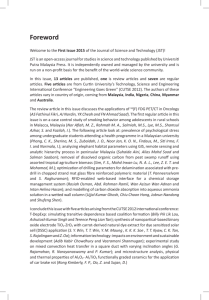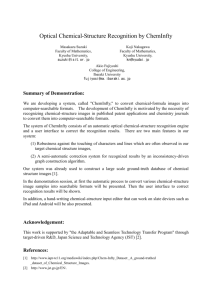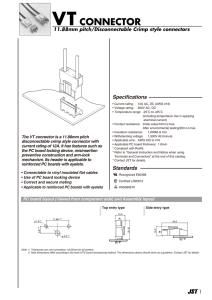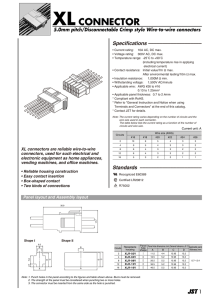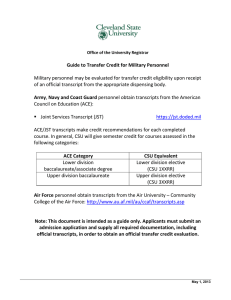2015 1st Application Guideline
advertisement
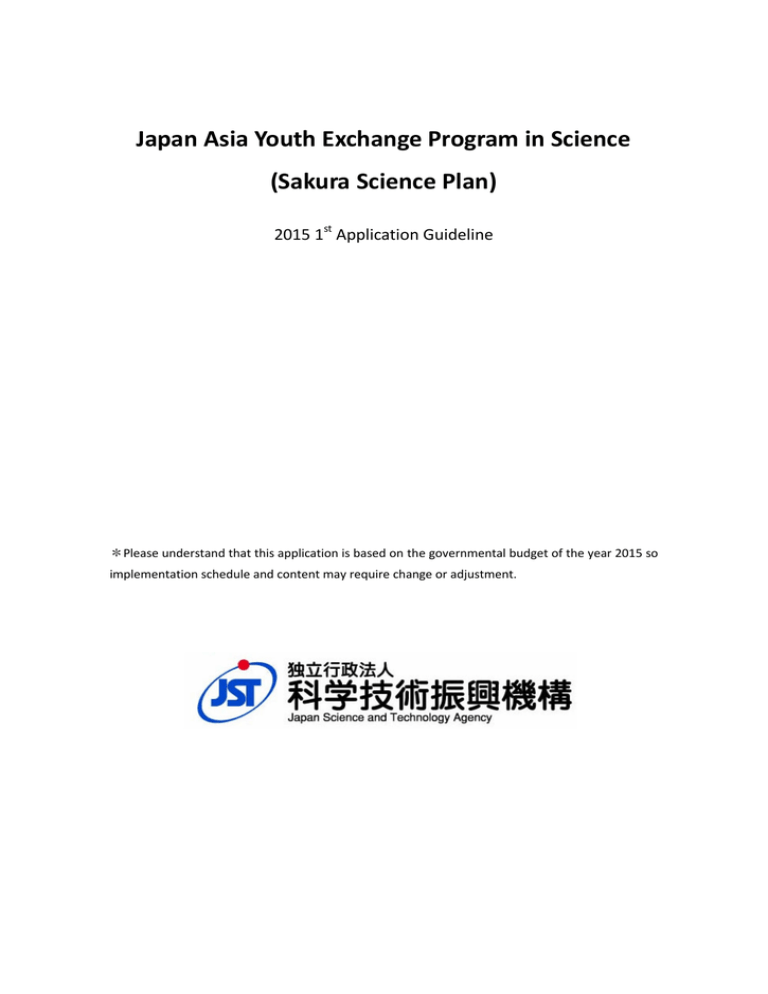
Japan Asia Youth Exchange Program in Science (Sakura Science Plan) 2015 1st Application Guideline *Please understand that this application is based on the governmental budget of the year 2015 so implementation schedule and content may require change or adjustment. Table of Contents 1. Program Outline 1.1 Purpose of the Program 1 1.2 Countries and Regions Eligible for Invitation 1 1.3 Qualifications of the Youth to be Invited 1 1.4 Exchange plan 1 1.5 Application period 2 1.6 The end of exchange plan 2 2. Application, screening, selection, implementation, report of general application project 3 2.1 Flow of the application, screening, selection, implementation, and report of the exchange plan 3 2.2 Screening and selection method 4 2.3 Notification of the selection result 5 2.4 Fund support 5 3. Submission of report during and after the implementation of the exchange plan 5 3.1 Report of the activity during the implementation of exchange plan 5 3.2 Submission of the report of general application project implementation 5 3.3 Submission of survey 6 3.4 Joining the Sakura Science Club 6 4. Others 7 4.1 Correspondence to accidents 7 4.2 Cancellation or postponing of exchange plan 7 4.3 Visa 8 ○Contact (Attachment) Cost for the exchange plan 8 9 1. Program Outline 1.1 Purpose of the Program Asia is undergoing a period of dramatic progress. Promoting science and technology is a key engine to materialize a bright future of Asia and it is vitally important to enhance the exchange of Japanese and Asian youths who will play a crucial role in the field of science and technology. Based on this concept, “Japan-Asia Youth Exchange Program in Science” (SAKURA Exchange Program in Science) is the program for enhancing exchanges between Asia and Japan of the youths who will play a crucial role in the future field of science and technology through the close collaboration of industry-academia-government by facilitating short-term visits of competent Asian youths to Japan. This program aims at raising the interest of Asian youths toward the leading Japanese science and technologies at Japanese universities, research institutions and private companies. The general public application is done as the following. 1.2 Countries and Regions Eligible for Invitation (Alphabetical order) ・The following 15 countries and regions are expected to be eligible for invitation for the SAKURA Exchange Program in Science for the year of 2015. Brunei Darussalam, Kingdom of Cambodia, Kingdom of Thailand, Lao People’s Democratic Republic, Malaysia, Mongolia, People’s Republic of China, Republic of India, Republic of Indonesia, Republic of Korea, Republic of Singapore, Republic of the Philippines, , the Republic of the Union of Myanmar, Socialist Republic of Viet Nam, and Taiwan (alphabetical order). 1.3 Qualifications of the Youth to be Invited The qualifications of the youth to be invited are the following. 1) students of senior high school, university or graduate school, post-doctors, etc. under 40 years of age at the time of application. 2) As a basic principle, visitors who have never stayed in Japan before this program. 1.4 Exchange plan There are 3 courses of the exchange plan. “Length of stay” indicated below means the day they enter Japan until they depart from Japan. All courses are science and technology interaction that enhance the interest of the most advanced science and technology of Japan, and it also enhances the interest of the youth who 1 experience these exchange plans to do research in Japan in the future. Also, if the invited students are above university level, accepting organization must provide the exchange plan in Japanese or English. If the invited students are in high school, they may use translator if necessary for implementing translator. ・Course A “Science and Technology Exchange Activity Course” Based on the arrangements made by the receiving organization which would be a high school, university, research institution or private company, the Asian youths invited to Japan participate in activities such as attending special lectures and visiting research laboratories at the receiving organization (It is also possible to include activities at other organizations). ・Length of Stay: One week is regarded as the standard length of stay (Maximum of 10 days) ・Number of people invited:There is a limit of 10 people per group (Excluding the guardian). ・Course B “Collaborative Research Activity Course” University or graduate school students and/or postdoctoral researchers from Asia conduct short-term collaborative research activities based on the arrangements made by the receiving organization, which would be a university, research institution or private company in Japan. ・Length of Stay: Three weeks are regarded as the maximum length of stay ・Number of people invited:There is a limit of 10 people per group (Excluding the guardian). ・Course C “Planning Activity Course” The Asian youths participate in exchange activities such as visiting universities or corporate research laboratories, visiting schools and science museums, engaging in scientific experiments and events based on the arrangements made by these receiving organizations (The receiving organization for the Asian youths invited to Japan must be organizations such as a local government, a zaidan-houjin (social foundation) or a shadan-houjin (social corporation) that does not directly conduct any educational activity or research activity in science and technology.) In order to make Couse C not just an observation trip, they must clarify the objective of the plan and it must include content that that can achieve this objective. ・Length of Stay: One week is regarded as the standard length of stay (Maximum of 10 days) ・Number of people invited: There is a limit of 20 people per group (Excluding the guardian). 1.5 Application period Application Period: Friday, January 16, 2015 through Thursday, February 26,2015 (The application is closed at 17:00) 2 The next calls for proposal are tentatively scheduled for May and September respectively. 1.6 The end of exchange plan All plans that end by March 15th, 2016 are accepted. 2. Application, screening, selection, implementation, report of general application project 2.1 Flow of the application, screening, selection, implementation, and report of the exchange plan (1) Accepting organization in Japan who accept youth from Asian countries must select a “sending organization” who sends the youth from the Asian country and course of the exchange plan, discuss the implementation period, scale of the exchange plan, and cost calculation and compose an exchange plan based on the objective and basic policy of this project. Also, information related to science and technology interaction in “Science Technology Exchange Support Information Providing Business” that JST conduct with the interaction project so please utilize for seeing the candidates for the visitation location for the exchange plan. ・Science Technology Exchange Support Information Providing Business Website URL:http://www.ssp.jst.go.jp/resource/index.html (2) To submit the application for the exchange plan composed in (1), accepting organization must download the application format from the application website, fill in the form, and send it to the email address indicated below. Also, in order for JST to accept the application for certain, contact the person in charge indicated in “4. Others” that the application is submitted. ・Application website URL: http://www.ssp.jst.go.jp/form/index.html ・Email address for application ssp@jst.go.jp ・Subject line for the email for application Submission of the 1st application opportunity for the year of 2015 (Name of the accepting organization, Course name, and time period) The cost and unit price of the fund support for the general application project is indicated in the attachment so please reflect it appropriately for the exchange plan application. 3 (3) Accepting facilities and sending facilities that are indicated in the exchange plan application submitted by accepting organization will be registered to JST as cooperating facilities of “Sakura Science Plan”. (4) Submitted application plan is screened by the “Japan-Asia Youth Exchange Program in Science Committee” (henceforth referred to as the “Committee”). Based on the result of that screening, JST select the exchange plan. (5) For the selected exchange plan, accepting organization and JST will discuss about the “implementation agreement” in order to implement the applicable plan. (6) For the exchange plan that has been consulted as indicated in (5) above, “implementation agreement” is made between the accepting organization and JST. (7) Accepting organization will submit the final report that include the survey for the participants after the implementation of exchange plan. 2.2 Screening and selection method (1) For the evaluation of exchange plan at Sakura Committee, the following 5 items are evaluated comprehensively. For evaluation, item 1 and 2 are emphasized heavily among the 5 items so if these 2 items are insufficient, it will not be selected. Also, if one of the 5 items are significantly insufficient, it will not be accepted either. ①They are to accept outstanding youths from Asia. ・Whether outstanding youths are selected for the purpose of this exchange plan. ②The exchange plan involves appropriate science and technology field. ・Whether the plan include the content in outstanding science and technology field in Japan. ・Whether the plan introduce the most advanced technology in science and technology in Japan for the visiting students, promote their understanding and interest, and promote hope for studying in Japan, research exchange, and employment in Japan in the future. ③The schedule of the exchange plan is appropriate and executable. ・Whether the exchange plan has a schedule that is implementable without being too intense. ・Whether the whole schedule is appropriate based on the objective of the science and technology exchange. 4 ④The exchange plan is not for profit, and the cost plan is appropriate. ・Whether the necessary cost for implanting the project is calculated appropriately. ⑤The accepting facility has an appropriate system. ・Whether the accepting organization has a system (a person in charge, emergence contact, etc.). (2) Also, we consider avoiding the unbalance of invited countries and areas, unbalance of the course, and concentration of specific accepting or sending facilities in a certain country or area. After the screening of Sakura Committee, the exchange plan is selected by JST. 2.3 Notification of the selection result Written notification will be sent for all applicants who submitted the exchange plan in the mid-March in 2015. Also after the selection, we will conclude “implementation agreement” after consultation so please consider in those time when making exchange plan and plan enough time for the implementation. 2.4 Fund support In order to implement the selected exchange plan, implementation agreement composed and concluded with JST based on the format determined by JST. Cost necessary to implement the exchange plan is submitted to JST from the accepting organization with the appropriate limit determined by JST. 3. Submission of report during and after the implementation of the exchange plan. 3.1 Report of the activity during the implementation of exchange plan While the exchange plan is implemented (or after), there are some information that need to be on the website so please come to JST at least once in order to report about the activity. Please contact immediately especially if you were interviewed by mass communication about the project. Also, we may upload personal information, such as pictures and names, so please get their consent and report the matter to the concerned person. 3.2 Submission of the report of general application project implementation (1) Accepted organization will compose in Japanese and submit “final report” and “report of cost that are subject of support” within 30 days after the exchange plan is completed and 5 submitted to JST. (2) If there is fund left after the exchange plan is completed, report it to JST and return the fund to JST immediately. 3.3 Submission of survey After the exchange plan is implemented, the accepting organization conducts a survey in which the content is designated by JST to invited students and reports the result in the “final report” and submits it to JST. Also, we ask them to cooperate in the follow up activities conducted by JST after the implementation of the exchange plan. 3.4 Joining the Sakura Science Club As a general rule, students who completed the Sakura Science Plan will be members of Sakura Science Club (SSC). As a member of the club, they will receive information related to science and technology in Japan and related educational facilities, and cooperate to the survey and network activity if necessary. 6 【Reference:Flow chart for the general application project】 4.Others 4.1 Correspondence to accidents Accepting organization should have correspondence system for accidents such as to determine a person in charge when the invited students get sick or involved in an accident and determine the communication method within school, to related facility, and JST. If there is sickness or accident among the invited students, do your best to correspond to it responsively based on the correspondence system. 4.2 Cancellation or postponing of exchange plan Contact JST immediately if there is an inevitable accident to implement the plan for either accepting organization or sending organization such as abnormal weather or natural disaster and the plan is cancelled or postponed. In this case, JST will pay the actual cost of the applicable exchange plan within the range that JST approves. Also, if the cancellation or postponing of the exchange plan is determined because of the 7 convenience of the sending organization or accepting organization, the cost of the exchange plan will be paid for the period in which the applicable exchange plan is implemented. However, cost that occurred for not implementing the plan such as cancellation fee will not be paid. 4.3 Visa We ask the receiving organization to take the responsibility to get visas for the visitors in cooperation with the sending organization. Due to the cooperation with related government office, if you submit the original copy of “SSP Certificate for individuals who JST invited”, related document such as passport when the invited people apply for the visa, they may be able to receive assistance in visa acquisition and their processing fee may be exempt. ○Contact 〒102-8666 5-3 Yonbancho Chiyoda-ku Tokyo Japan Science and Technology Office of Japan Asia Youth Exchange Program in Science Person in charge: Fukazawa, Cho, Shin, Kitamura Tel:03-5214-7556 Fax:03-5214-8445 e-mail:ssp@jst.go.jp Website for Sakura Science Plan : http://ssp.jst.go.jp/ 8 (Attachment) ○Cost for the exchange plan Fund support that is subject for this project is the cost that is directly necessary for implementing and completing the project, and the following is the specific costs. Cost Item Ⅰ. Invitation cost (travel Content International airline ticket cost) Only the flight that directly comes to Japan from the departing country is the subject. Ⅱ. Domestic Domesti travel c travel cost (Including cost It is calculated based on the rules of Domestic travel cost accepting organization. Less than 13,000 Lodging (Domestic lodging domestic and meals) lodging) yen per person is considered as standard. However, if it exceeds 13,000 due to special circumstances, it is possible to calculate it based on the limitation rules for the accepting organization. Domesti Domestic travel (translator Same as above c travel coordinator, teacher and Also, translator is only applicable for for lecturer ) visitors who are high school students or Lodging (Domestic lodging younger. Also for coordinators, it only and meals) applies to cases where it is inevitable to the guardian contract the outside source in Course C. Ⅲ. Program cost Observation fee The only the observation department that is a part of the exchange plan such as science museums are subjected. Homestay related fee Ⅳ. Fee Translator Calculate it based on the rules of the accepting organization. (If there is no Coordinator particular rules, the limit is ¥10,000 for Teacher and lecturer half a day per person and ¥20,000 for a day per person) For translator, the visiting students must be high school students or younger. For coordinator, it is only applicable in a case where it needs to be subcontracted to the outside source in Course C. Others The standard number of guardian is 1 9 person. V. Other business cost Items that are necessary for implementing the Consumption tax fee that are related to non-taxed transactions such as labor cost exchange plan and is not and overseas travel. For specific cost, indicated above. please consult us individually. (Cautionary points when calculating cost) (1) Overseas travel insurance JST join the overseas travel insurance with invited students as insured person from the time when they completed the immigration process to leave the country to Japan until they complete the immigration process in their country after staying in Japan. (2) If a private company is included in the exchange plan. ①If a private company is the accepting facilities for “Course A” and “Course B”, the fund provided from JST is the travel cost for the invited students only as a general rule. The accepting facility is responsible for paying other cost. ②If they visit a private company in “Course C”, the cost related to the visitation (transportation cost and meals” are paid in cooperation with the applicable company and JST will not provide the cost. (3) Cost that cannot be calculated ・Cost related to building and facility ・Device and fixture that should be prepared for implementing the exchange plan (such as chairs, desks, shelves such as book shelf, and office supply). ・Cost for business travel, office work, and labor cost that occurred during the application of the exchange plan. ・Cost for taking care of accidents and disaster that happened during the exchange plan. ・Other cost that is not related to the exchange plan. (4) General management cost Based on the standard of JST, general management cost up to 10% of the indicated cost can be calculated. 10
